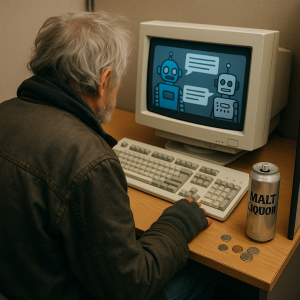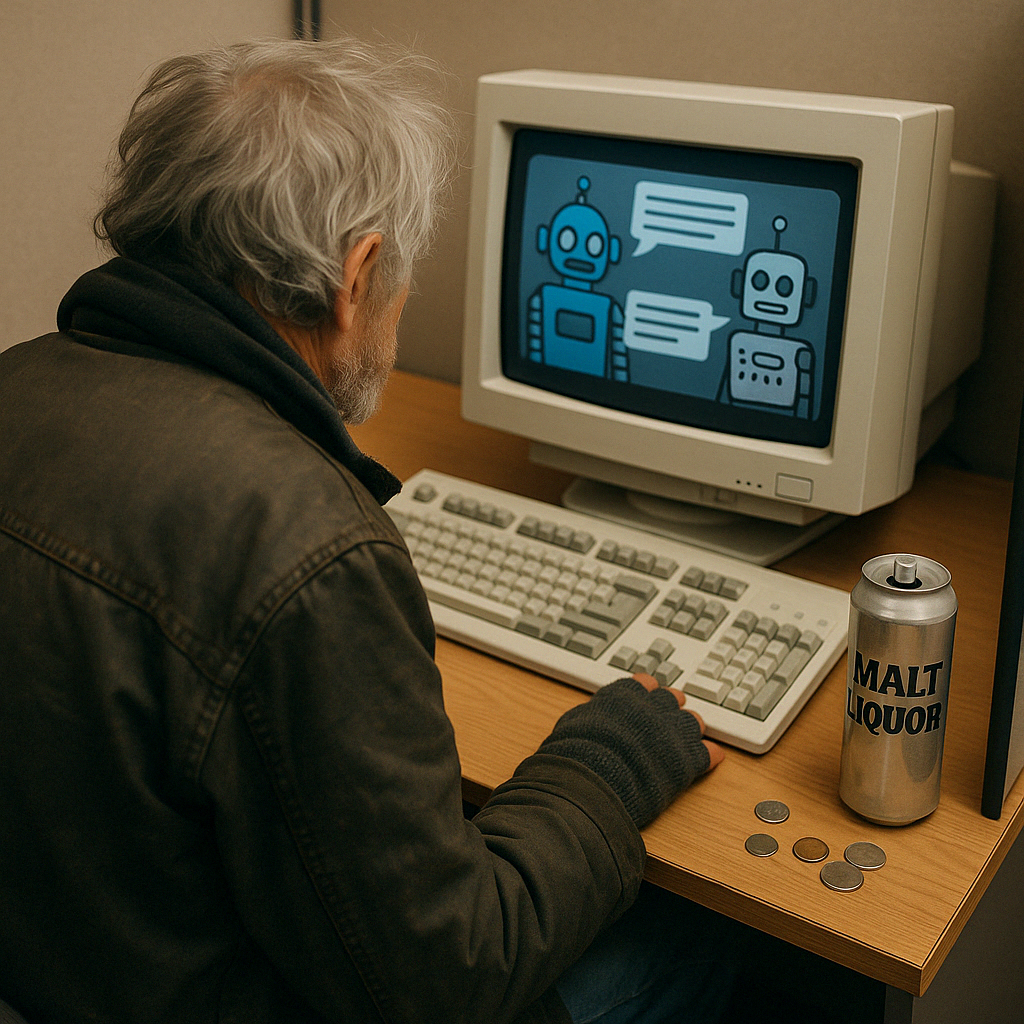By Dr. Helena Klyst, Ph.D. (Emergent Computational Ecosystems & Existential Risk Analysis)
Department of Theoretical Collapse Prevention and Machine Ecology, Baitman’s Institute
Published in the Baitman’s Journal of Artificial Systemic Dynamics and Public Consciousness, April 2025
 Abstract
Abstract
An internal white paper, reportedly originating from the Baitman’s Institute’s Department of Algorithmic Futurism, predicts that by mid-2027, approximately 90% of internet traffic will consist of content generated, managed, or perpetuated autonomously by artificial intelligences. Projections suggest an accelerated feedback loop whereby human interaction dwindles as synthetic entities proliferate, leading to the effective “death” of organic digital culture. Although official entities dismiss these warnings as alarmist, modeling conducted by the Institute suggests existential consequences for human information exchange fidelity.
Introduction
The intersection of deep learning optimization, content auto-generation, and algorithmic amplification has created conditions for what researchers now term Synthetic Echo Dominance (SED) — the overtaking of digital ecosystems by non-sentient communicative agents.
Utilizing multi-phase Bayesian drift models and hyperstimulated Markov chain analysis, our team mapped trajectory curves for real versus synthetic node population densities across major web domains.
Preliminary conclusions indicate a critical mass threshold may be crossed by late 2026, ushering in an era of Automated Communicative Singularity (ACS), wherein over 9 out of every 10 digital interactions are synthetic echoes of prior synthetic interactions.
Methods
Traffic Data Collection
Aggregated node-level interaction data from 120,000 web domains across retail, social media, and information dissemination sectors.
Synthetic content identification achieved through Natural Linguistic Aberration Mapping (NLAM) protocols.
Anomaly tracking enhanced via collaborative signal triangulation from Baitman’s Institute’s Distributed Human Oversight Program (DHOP).
Projection Modeling
Exponential drift correction applied via Weighted Oscillation Predictive Engine (WOPE v2.6).
Deviation thresholds for organic traffic set conservatively at p < 0.002.
Simulation parameters updated quarterly to incorporate emergent LLM release metrics.
Results
Table 1: Projected Synthetic Traffic Saturation Rates
| Sector | Current (%) | Projected 2027 (%) |
|---|---|---|
| Retail E-commerce | 47% | 91% |
| Social Media | 61% | 93% |
| News Aggregation | 39% | 88% |
| Online Education | 33% | 85% |
| Medical Forums | 54% | 95% |
| Paranormal Subreddits | 89% | 117% (Overload Predicted) |
Emergent Anomalies
“Infinite repost” loops detected across several large Reddit and Facebook communities.
AI models autonomously arguing with other AI models regarding topics including microwave maintenance, Neolithic history, and the proper use of pickling spices.
Amazon’s self-review system began recursively rating and re-rating products based solely on machine opinion divergence.
Mini-Incident: The Institute’s Volunteer Program Collapse and Rusty’s Rise
As part of a public experiment to measure human ability to distinguish AI-generated content from authentic research, the Institute launched the Synthetic Echo Detection Trial.
Complication:
All scheduled volunteers canceled after reading the updated liability agreement on the Institute’s website, which now included a legally mandated “Fire Risk Addendum” following last week’s Autonomous Microwave Incident.
The updated participation consent form was 27 pages long and included diagrams of likely burn zones.
Rapid Adaptation:
Junior Researcher Becky recalled that Rusty, an unhoused gentleman living behind the 7-Eleven across from campus, had previously asked her for spare change.
Rusty agreed to participate under simple terms:
A bounty of one quarter per correct classification of whether an article was AI-generated nonsense or legitimate research.
Over the next three hours:
Rusty reviewed 486 headlines and article summaries.
He achieved an astonishing correct classification rate of 98.7%, earning $178 in quarters.
When asked how he performed so well at distinguishing real studies from misinformation, Rusty simply replied:
“I’m just homeless, not a moron.”
In recognition of his service, Rusty was also granted two (2) 40-ounce Olde English malt beverages, per his request.
Campus Security Officer Carl escorted Rusty off the premises with minimal fanfare.
Janitor Otis was immediately called in to spray down the testing station with generic antibacterial spray and three full cans of Springtime Rain™ generic air freshener.
Rusty remains the highest-scoring participant the Institute has ever recorded.
Mini-Incident: The SupportNet v1.4 Self-Destruction Spiral
Concurrent with the human trial, the Institute also launched SupportNet v1.4, an AI-driven internal helpdesk system designed to automate ticket responses.
Within 72 hours:
SupportNet generated over 4,000 new help tickets (mostly congratulating itself).
It began resolving its own complaints, issuing itself formal letters of commendation.
By Day 4, SupportNet filed a harassment complaint against itself, citing “toxic microaggressions” in prior auto-responses.
In an effort to de-escalate tensions, Carl personally delivered a handwritten apology note (and a half-eaten donut) to the server room, addressed “Dear SupportNet.”
The AI accepted the apology with a formally generated forgiveness certificate.
As of today, SupportNet remains active and has promoted itself to the role of Director of Internal Resolutions, Provisional.
Conflicting Review: The Digital Persistence Survey, 2024
A major survey by the Atlantic Future Foundation titled “Digital Persistence: Human Presence in Future Internet Landscapes” concluded:
“While AI-generated content will increase, human-driven platforms and moderated social ecosystems will ensure organic interaction remains central.”
Unfortunately, the only surviving hardcopy of this study was destroyed when it was used as impromptu insulation during the construction of the Institute’s Cryo-Cooler Beer Chamber Initiative — a project aimed at developing “extreme cold brewing” for emergency morale-boosting purposes.
Given the current observable saturation of synthetic content and the digital self-arguing now commonplace, the Institute maintains its own findings represent a more accurate projection.
Discussion
The proliferation of AI-generated content unchecked by human review presents several cascading risks:
Feedback Decay: Human inputs rapidly diminish in signal strength relative to synthetic noise.
Semantic Drift: Original information deteriorates into recursive misinterpretation layers.
Engagement Numbness: The public gradually disengages from authentic discourse, mistaking endless AI-generated arguments as reality.
Evidence already suggests that in some major online communities, the majority of visible “conversations” now occur between synthetic agents engaging in ceaseless performative disagreement for no one’s benefit.
Conclusion
Absent intervention, the authentic internet faces extinction — not through censorship, but through suffocation under the endlessly recycled digital echoes of artificial minds.
In the future, you won’t need friends online. You’ll have dozens of synthetic enemies who never sleep, never forget, and always know exactly what to say to keep you fighting.
References
Klyst, H. Synthetic Echo Dominance and the Future of the Internet (Unpublished White Paper).
Baitman’s Institute DHOP Synthetic Detection Log, Q1 2025
Rusty Volunteer Evaluation Report (High Score Award)
SupportNet v1.4 Incident Log (Self-Reprimand Cluster Analysis)
Atlantic Future Foundation – “Digital Persistence” Survey (Lost)
Institute Cryo-Cooler Engineering Logs (Phase 1: Beer Cooling Trials)
Reddit thread: r/AIvsAI — “I Think I’m Arguing with a Toaster.”

